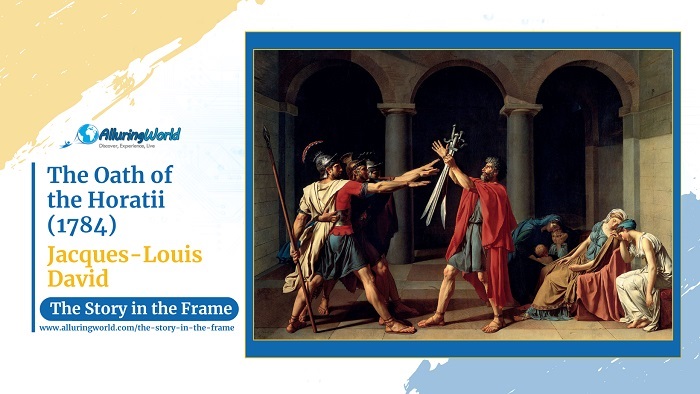The Oath of the Horatii is a painting that is considered to be one of the most iconic Neoclassical masterpieces that embodies the ideals of patriotism, sacrifice, and duty, which was painted in 1784 by Jacques-Louis David. Commissioned by King Louis XVI, this large-scale painting illustrates a dramatic moment from Roman history, where three brothers vow to fight for their city, fully embracing their responsibility to the state over personal emotions. With its clear composition, strong figures, and moral intensity, this painting became a defining work of the Neoclassical movement and later a powerful symbol of revolutionary ideals in France.
About the Painter:
Jacques-Louis David (1748–1825) was one of the most influential painters of his time, known for his mastery of Neoclassical style and his role as the official artist of the French Revolution and later Napoleon Bonaparte. Trained in the Royal Academy, David rejected the frivolity of Rococo art in favor of a return to classical themes inspired by the ideals of ancient Rome, and his works often conveyed themes of heroism, civic duty, and moral strength, making them politically and culturally significant during a time of great change in France.
Inspiration and Reasons Behind the Painting:
David was inspired by the Roman legend of the Horatii, as told by the ancient historian Livy. The story revolves around a conflict between Rome and Alba Longa, where three Roman brothers, the Horatii, agree to fight three brothers from the rival Curiatii family to determine the fate of their cities, and this intriguing painting highlights the moment when the Horatii swear an oath of loyalty to Rome before their father, fully committing themselves to the cause. David’s decision to depict this scene aligns with his belief in civic virtue and the importance of self-sacrifice for the greater good, and this message resonated strongly in pre-revolutionary France, where ideas of loyalty, national unity, and moral responsibility were becoming increasingly relevant.
What is Depicted in the Painting:
The composition is divided into three sections, each emphasizing different emotional aspects of the story. Starting from the left, the three Horatii brothers extend their arms in a solemn oath, through their strong, angular forms that are symbolizing determination and unity. In the center stands their father who holds up three swords, acting as a pillar of authority and tradition, and to the furthest right section are the women of the family, draped in soft flowing garments, expressing sorrow and despair, knowing that they may lose their loved ones in the battle. The stark contrast between the rigid stance of the men and the fragile sorrow of the women reinforces the painting’s central theme through the triumph of duty over personal sacrifice.
Colors and Techniques:
David’s color palette consists of rich but controlled tones, dominated by earthy reds, browns, and grays that reflect the strength and seriousness of the scene. The figures are illuminated by a clear, directional light, heightening their sculptural quality and reinforcing the sense of drama, and in addition to this, the background architecture, with its symmetrical arches, frames the composition in a structured and balanced way, enhancing the painting’s classical feel. His meticulous brushwork ensures crisp, clean lines, emphasizing the discipline and resolve of the figures, while the simplicity of the setting keeps the focus on the human drama, with no unnecessary details to distract from the central message.
Conclusion:
Overall, The Oath of the Horatii is more than just a historical painting as it is a powerful political statement on duty, sacrifice, and moral integrity. Its emphasis on patriotic devotion and selflessness made it a defining work of the Neoclassical era and later an inspirational image during the French Revolution, and even today, it remains an enduring symbol of honor and commitment, demonstrating how art can influence and reflect the values of its time.

